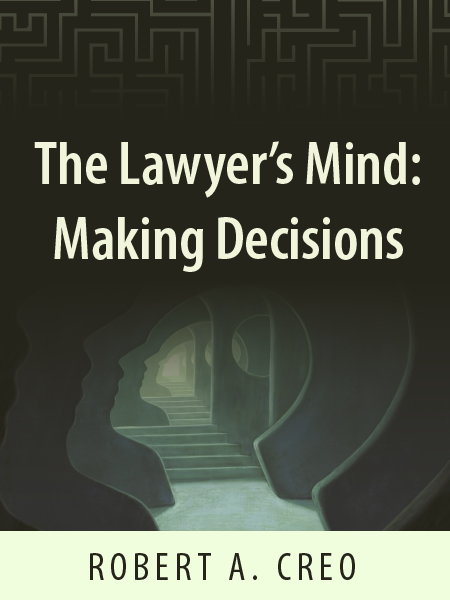
Lawyer unfamiliarity, misconceptions and personal defensiveness about decision-making processes impede professional development and limit the effective representation of clients. We often deflect criticism, resist changing our opinions, avoid feedback, and stay the course despite mounting evidence that things are not going so well. Lawyer toolkits overflow with aggression, avoidance, intimidation, blaming, deflecting, and other competitive tactics, which often do not work and only energize or entrench the opposition. Many highly successful people lack self-awareness and resist behavioral changes that can enhance problem-solving skills.
This article explores judgment, decision-making theory and practice, persuasion skills, and mental hardwiring, including cognitive defaults and biases that impact choices, advice, and courses of action in client representation. The current series explores judgment, decision-making, and persuasion skills.
Once a cat sits on a hot stove, it will never sit on one
again, or a cold one.
—Mark Twain
HOW WE THINK
We are creatures of our experience. Being “burned” once can sear the experience into our memory such that avoidance of adverse consequences becomes the automatic or default in decision-making. Research continues to show that the overwhelming majority of people value the avoidance of loss more than the reward of comparable gains. Loss aversion is one of many cognitive biases that affect our decision-making process and negatively impact critical and reflective thinking.
Humans strive for coherency and cogency. We rely on structure, routine, and pattern recognition to conserve energy and quickly make choices for self-preservation and efficiency. Lawyers, for example, consciously or unconsciously develop “decision habits,” which act as guides for tactical choices made during the course of representing a client. Counsel thrive in the flow of events, sometimes referred to as the “valley of the normal,” where things are neither unexpected nor surprising. The legal system operates in the context of base values and communal experiences. As one law student of mine commented, the rules of courtroom procedures do not have to expressly prohibit counsel from punching the judge following an adverse ruling.
Common sense and cultural norms are unspoken and form the informational foundation for action, but this is not enough to resolve disputes. No matter how much discovery is conducted, including the boiler-shop review of vast quantities of electronic communications, information will be incomplete, contextual, or rationalized in hindsight. It is easy to unintentionally conflate correlation with causation, especially in the realm of legal advocacy. Whenever there is causation, there is correlation but not the inverse. An acquaintance commented that the Steelers always win or lose when he is present or wearing a specific item of clothing, but this correlation does not equal causation. Most of us want to believe we have more agency and impact on what is happening, when, in reality, we have nothing to do with it.
Another aspect of this decision error is “causal thinking.” When something new happens, the human mind streams it into an inevitable chain of events triggered by an earlier event, despite numerous other factors having intervened to affect the outcome. Once the outcome is known, causal thinking results in an explanation for the event-chain being linked and predictable. As the authors of the book Noise, A Flaw in Human Judgment point out, causal mode comes more naturally where causality is plausible. Minds easily turn some correlation, however low, into a causal and explanatory force. Reliance on flawed explanations occurs when the alternative is to reduce understanding of our world and ourselves. Inherent in complex disputes is the presence of conflicting signals, clues, and cues (i.e., noise working against the biological drive for coherence).The inherent need to create patterns and coherency blurs circumstances and context, like the cat that is unable to discern a cold stove from a hot one. Lawyers may too quickly dismiss viable options and tactics by not taking the time and energy to identify and assess the nuances of the facts or dynamics of the stakeholders.
Many of us have faced the difficult task of explaining consequential damages and articulating foreseeability to clients and juries. When there are unexpected but unsurprising outcomes, a narrative in hindsight creates a coherent and reasonable story. Because the event explains itself in the context of later activities, our hindsight bias creates an illusion that the event could have been predicted, and we conclude that it was reasonably foreseeable.
Advocates with an eye to dispute resolution and litigation focus on building narratives, illusory or not, and creating causation to explain the past so that liability and responsibility can be apportioned in a manner favorable to the client. This involves dissecting past relationships to find patterns and correlations in search of causation and provable consequential damage, so that these stories, theories, or themes of the case create victims and villains to shift responsibility from one client to others. Transactional representation involves the forecasting and allocation of risk within the business and cultural norms of the substantive area or business sector. The goal is to avoid surprises and to manage and navigate potential abnormalities while assigning future responsibility to each participant in the transaction. Compliance lawyers are a subset of transactional lawyers whose area of expertise is administrative and regulatory advocacy, advising clients operating within the designated and acceptable mandates of regulations.
CLICK HERE to read the full article, which was originally published in ALI CLE’s The Practical Lawyer.
The Practical Lawyer

Subscribe to the print or digital version of The Practical Lawyer today.
